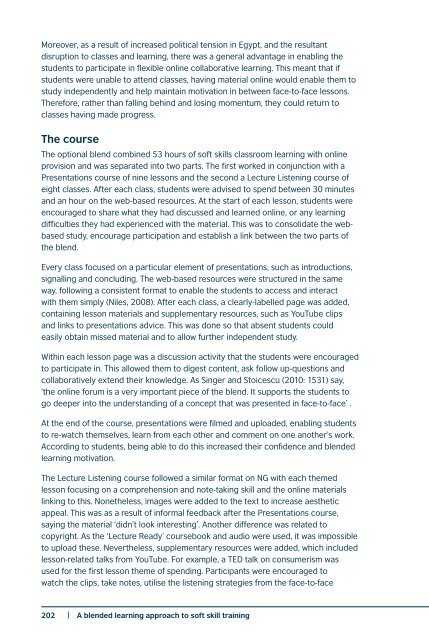Blended Learning in English Language Teaching: Course Design and Implementation
Blended Learning in English Language Teaching: Course Design and Implementation
Blended Learning in English Language Teaching: Course Design and Implementation
Create successful ePaper yourself
Turn your PDF publications into a flip-book with our unique Google optimized e-Paper software.
Moreover, as a result of <strong>in</strong>creased political tension <strong>in</strong> Egypt, <strong>and</strong> the resultant<br />
disruption to classes <strong>and</strong> learn<strong>in</strong>g, there was a general advantage <strong>in</strong> enabl<strong>in</strong>g the<br />
students to participate <strong>in</strong> flexible onl<strong>in</strong>e collaborative learn<strong>in</strong>g. This meant that if<br />
students were unable to attend classes, hav<strong>in</strong>g material onl<strong>in</strong>e would enable them to<br />
study <strong>in</strong>dependently <strong>and</strong> help ma<strong>in</strong>ta<strong>in</strong> motivation <strong>in</strong> between face-to-face lessons.<br />
Therefore, rather than fall<strong>in</strong>g beh<strong>in</strong>d <strong>and</strong> los<strong>in</strong>g momentum, they could return to<br />
classes hav<strong>in</strong>g made progress.<br />
The course<br />
The optional blend comb<strong>in</strong>ed 53 hours of soft skills classroom learn<strong>in</strong>g with onl<strong>in</strong>e<br />
provision <strong>and</strong> was separated <strong>in</strong>to two parts. The first worked <strong>in</strong> conjunction with a<br />
Presentations course of n<strong>in</strong>e lessons <strong>and</strong> the second a Lecture Listen<strong>in</strong>g course of<br />
eight classes. After each class, students were advised to spend between 30 m<strong>in</strong>utes<br />
<strong>and</strong> an hour on the web-based resources. At the start of each lesson, students were<br />
encouraged to share what they had discussed <strong>and</strong> learned onl<strong>in</strong>e, or any learn<strong>in</strong>g<br />
difficulties they had experienced with the material. This was to consolidate the webbased<br />
study, encourage participation <strong>and</strong> establish a l<strong>in</strong>k between the two parts of<br />
the blend.<br />
Every class focused on a particular element of presentations, such as <strong>in</strong>troductions,<br />
signall<strong>in</strong>g <strong>and</strong> conclud<strong>in</strong>g. The web-based resources were structured <strong>in</strong> the same<br />
way, follow<strong>in</strong>g a consistent format to enable the students to access <strong>and</strong> <strong>in</strong>teract<br />
with them simply (Niles, 2008). After each class, a clearly-labelled page was added,<br />
conta<strong>in</strong><strong>in</strong>g lesson materials <strong>and</strong> supplementary resources, such as YouTube clips<br />
<strong>and</strong> l<strong>in</strong>ks to presentations advice. This was done so that absent students could<br />
easily obta<strong>in</strong> missed material <strong>and</strong> to allow further <strong>in</strong>dependent study.<br />
With<strong>in</strong> each lesson page was a discussion activity that the students were encouraged<br />
to participate <strong>in</strong>. This allowed them to digest content, ask follow up-questions <strong>and</strong><br />
collaboratively extend their knowledge. As S<strong>in</strong>ger <strong>and</strong> Stoicescu (2010: 1531) say,<br />
‘the onl<strong>in</strong>e forum is a very important piece of the blend. It supports the students to<br />
go deeper <strong>in</strong>to the underst<strong>and</strong><strong>in</strong>g of a concept that was presented <strong>in</strong> face-to-face’ .<br />
At the end of the course, presentations were filmed <strong>and</strong> uploaded, enabl<strong>in</strong>g students<br />
to re-watch themselves, learn from each other <strong>and</strong> comment on one another’s work.<br />
Accord<strong>in</strong>g to students, be<strong>in</strong>g able to do this <strong>in</strong>creased their confidence <strong>and</strong> blended<br />
learn<strong>in</strong>g motivation.<br />
The Lecture Listen<strong>in</strong>g course followed a similar format on NG with each themed<br />
lesson focus<strong>in</strong>g on a comprehension <strong>and</strong> note-tak<strong>in</strong>g skill <strong>and</strong> the onl<strong>in</strong>e materials<br />
l<strong>in</strong>k<strong>in</strong>g to this. Nonetheless, images were added to the text to <strong>in</strong>crease aesthetic<br />
appeal. This was as a result of <strong>in</strong>formal feedback after the Presentations course,<br />
say<strong>in</strong>g the material ‘didn’t look <strong>in</strong>terest<strong>in</strong>g’. Another difference was related to<br />
copyright. As the ‘Lecture Ready’ coursebook <strong>and</strong> audio were used, it was impossible<br />
to upload these. Nevertheless, supplementary resources were added, which <strong>in</strong>cluded<br />
lesson-related talks from YouTube. For example, a TED talk on consumerism was<br />
used for the first lesson theme of spend<strong>in</strong>g. Participants were encouraged to<br />
watch the clips, take notes, utilise the listen<strong>in</strong>g strategies from the face-to-face<br />
202 | A blended learn<strong>in</strong>g approach to soft skill tra<strong>in</strong><strong>in</strong>g


